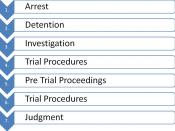The system of criminal procedure primarily utilized in the United States is the adversarial system. The term ÃÂadversaryÃÂ is easily interpreted to mean opposition. Our present criminal procedure pits two sides against each other to present their respective evidence and issues surrounding a criminal act. This paper will address the adversarial system and its expressed use in criminal court proceedings in the United States. Among the questions this paper will take into consideration are: Is the adversarial system the best way to achieve justice in the criminal courts of the United States; what those limitations are; how those limitations deliver justice; alternatives to the adversarial system; and the advantages or disadvantages of those alternatives.
Achieving JusticeWhen confronted with the issue of the best method to achieving justice in criminal court proceedings; one must understand what the adversarial system entails.
The use of a jury, the standard of evidence relied upon and the standard of proof, the cross-examining of witnesses and the ability to plead guilty, contribute greatly to reaching justice in the adversary system.
They are all reasons which help the adversary system in accomplishing fairness in criminal trials. The adversary system is a feature of the common law system and was brought to Australia with England. It has adapted to the Australian legal system. It is a system of trial where, ÃÂÃÂ the two sides of the case try to present and prove their version of the facts and disprove the version of the other side.ÃÂ(Cook, Creyke, & Geddes Hamer, 2005) A jury decides guilt or innocence, while a judge or magistrate guides the jury in areas of law, as well as deciding a suitable punishment for the defendant.
In criminal cases in the adversarial system of trial, justice is achieved through the use of evidence. In the adversarial system,


